The IOM Report & Nursing: Practice, Education, and Coalitions
VerifiedAdded on 2022/12/14
|7
|1670
|1
Report
AI Summary
This report examines the influence of the Institute of Medicine (IOM) report, "The Future of Nursing: Leading Change, Advancing Health," and state-based action coalitions on nursing practice, education, and workforce development. It begins by describing the Robert Wood Johnson Foundation Committee Initiative that led to the IOM report, highlighting its recommendations for redesigning care delivery, restructuring nursing education, and expanding nursing school capacity. The report then outlines the four key messages structuring the IOM report, explaining how they have transformed nursing practice through health policy changes, enhanced nursing leadership by promoting involvement in care redesign, prioritized diversity in the nursing workforce, and promoted continuous learning for professional skill enhancement. The role of state-based action coalitions in advancing the IOM report's goals is discussed, emphasizing their efforts to create environments where nurses can utilize their full capabilities. Furthermore, the report summarizes two initiatives by the Washington DC action coalition: committing to quality care without discrimination and campaigning for the implementation of IOM recommendations. Finally, it identifies barriers to advancement in Washington DC, such as state practice and licensure restrictions, and explains how nursing advocates are overcoming these barriers through policy initiatives.
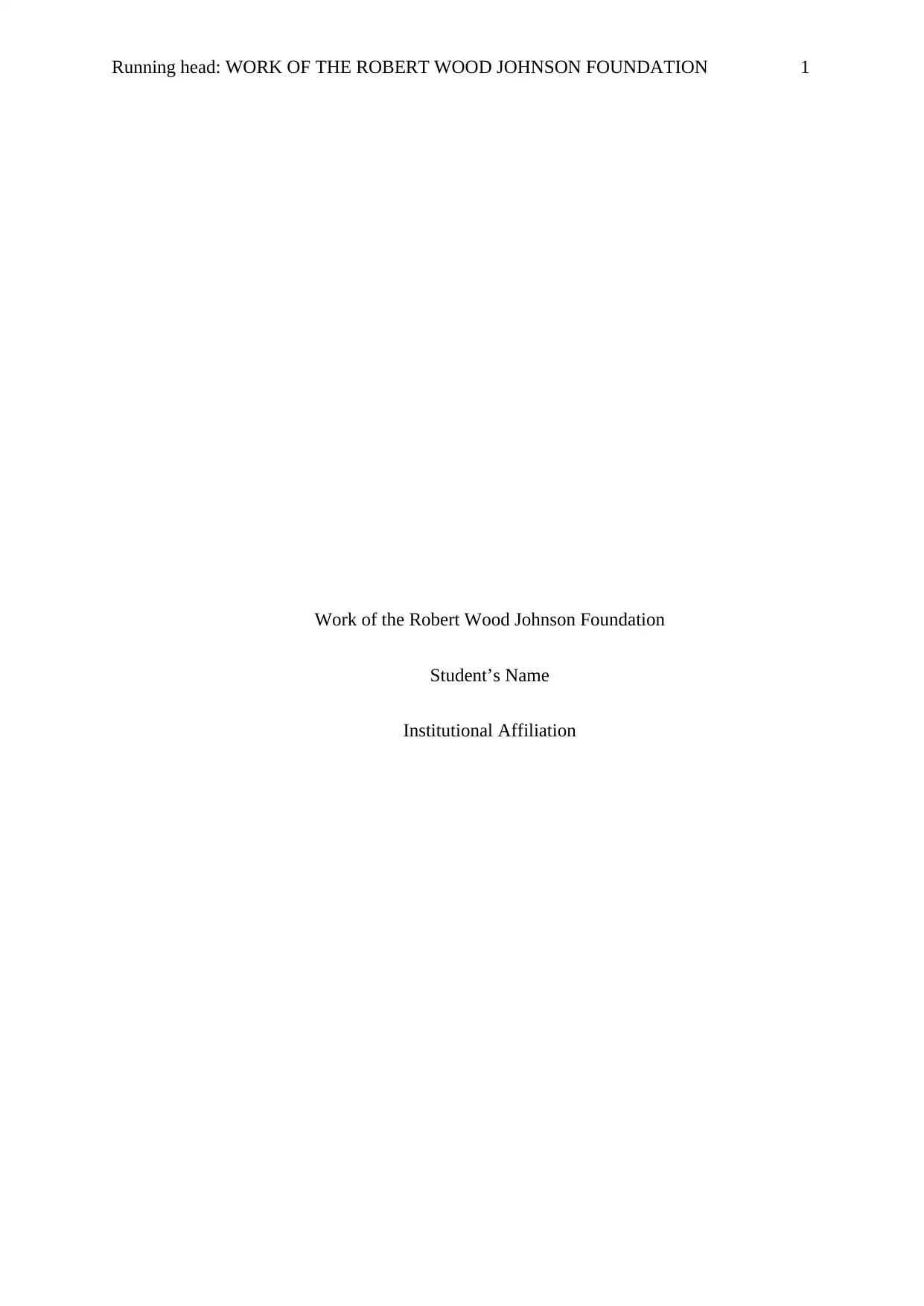
Running head: WORK OF THE ROBERT WOOD JOHNSON FOUNDATION 1
Work of the Robert Wood Johnson Foundation
Student’s Name
Institutional Affiliation
Work of the Robert Wood Johnson Foundation
Student’s Name
Institutional Affiliation
Paraphrase This Document
Need a fresh take? Get an instant paraphrase of this document with our AI Paraphraser
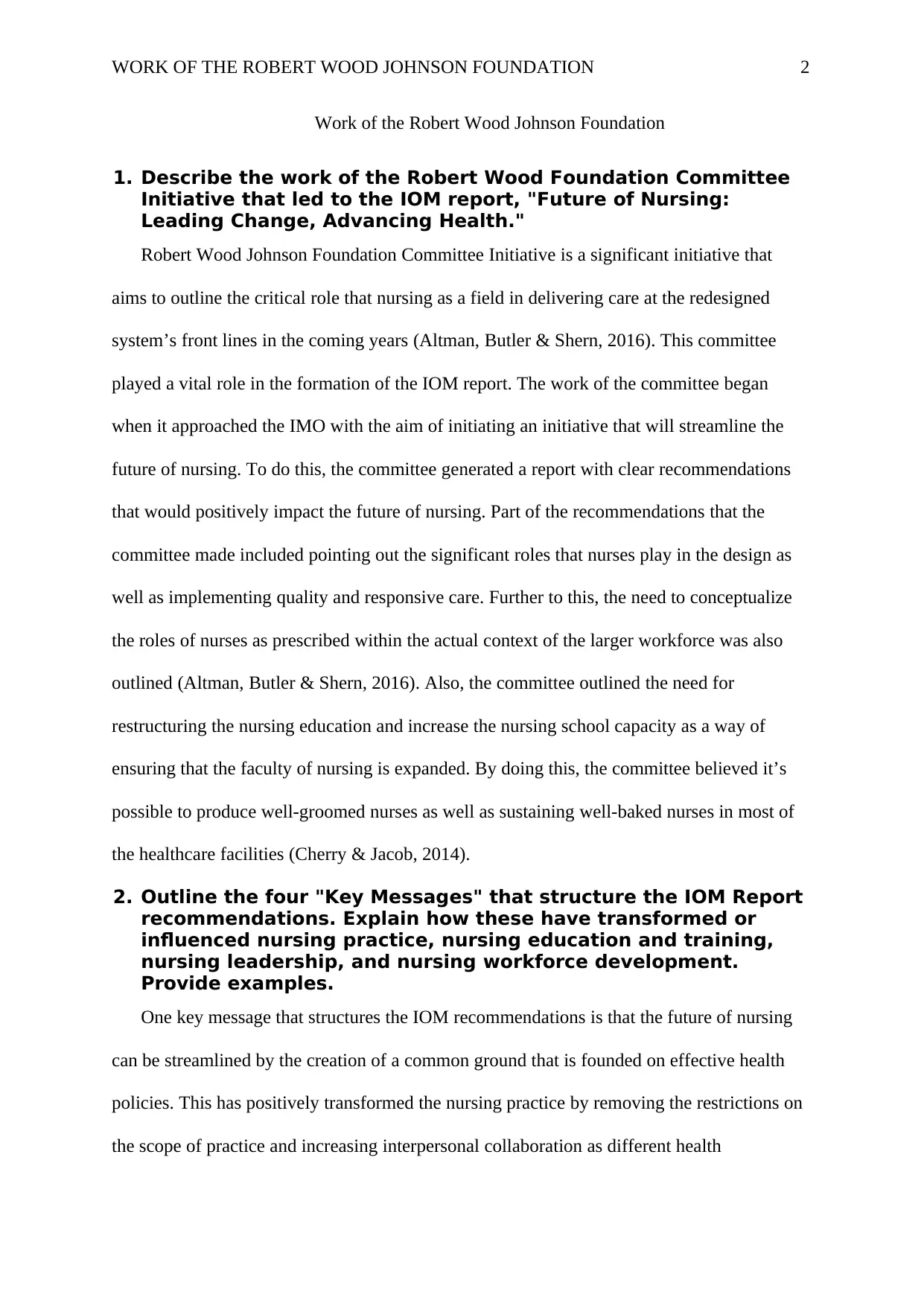
WORK OF THE ROBERT WOOD JOHNSON FOUNDATION 2
Work of the Robert Wood Johnson Foundation
1. Describe the work of the Robert Wood Foundation Committee
Initiative that led to the IOM report, "Future of Nursing:
Leading Change, Advancing Health."
Robert Wood Johnson Foundation Committee Initiative is a significant initiative that
aims to outline the critical role that nursing as a field in delivering care at the redesigned
system’s front lines in the coming years (Altman, Butler & Shern, 2016). This committee
played a vital role in the formation of the IOM report. The work of the committee began
when it approached the IMO with the aim of initiating an initiative that will streamline the
future of nursing. To do this, the committee generated a report with clear recommendations
that would positively impact the future of nursing. Part of the recommendations that the
committee made included pointing out the significant roles that nurses play in the design as
well as implementing quality and responsive care. Further to this, the need to conceptualize
the roles of nurses as prescribed within the actual context of the larger workforce was also
outlined (Altman, Butler & Shern, 2016). Also, the committee outlined the need for
restructuring the nursing education and increase the nursing school capacity as a way of
ensuring that the faculty of nursing is expanded. By doing this, the committee believed it’s
possible to produce well-groomed nurses as well as sustaining well-baked nurses in most of
the healthcare facilities (Cherry & Jacob, 2014).
2. Outline the four "Key Messages" that structure the IOM Report
recommendations. Explain how these have transformed or
influenced nursing practice, nursing education and training,
nursing leadership, and nursing workforce development.
Provide examples.
One key message that structures the IOM recommendations is that the future of nursing
can be streamlined by the creation of a common ground that is founded on effective health
policies. This has positively transformed the nursing practice by removing the restrictions on
the scope of practice and increasing interpersonal collaboration as different health
Work of the Robert Wood Johnson Foundation
1. Describe the work of the Robert Wood Foundation Committee
Initiative that led to the IOM report, "Future of Nursing:
Leading Change, Advancing Health."
Robert Wood Johnson Foundation Committee Initiative is a significant initiative that
aims to outline the critical role that nursing as a field in delivering care at the redesigned
system’s front lines in the coming years (Altman, Butler & Shern, 2016). This committee
played a vital role in the formation of the IOM report. The work of the committee began
when it approached the IMO with the aim of initiating an initiative that will streamline the
future of nursing. To do this, the committee generated a report with clear recommendations
that would positively impact the future of nursing. Part of the recommendations that the
committee made included pointing out the significant roles that nurses play in the design as
well as implementing quality and responsive care. Further to this, the need to conceptualize
the roles of nurses as prescribed within the actual context of the larger workforce was also
outlined (Altman, Butler & Shern, 2016). Also, the committee outlined the need for
restructuring the nursing education and increase the nursing school capacity as a way of
ensuring that the faculty of nursing is expanded. By doing this, the committee believed it’s
possible to produce well-groomed nurses as well as sustaining well-baked nurses in most of
the healthcare facilities (Cherry & Jacob, 2014).
2. Outline the four "Key Messages" that structure the IOM Report
recommendations. Explain how these have transformed or
influenced nursing practice, nursing education and training,
nursing leadership, and nursing workforce development.
Provide examples.
One key message that structures the IOM recommendations is that the future of nursing
can be streamlined by the creation of a common ground that is founded on effective health
policies. This has positively transformed the nursing practice by removing the restrictions on
the scope of practice and increasing interpersonal collaboration as different health
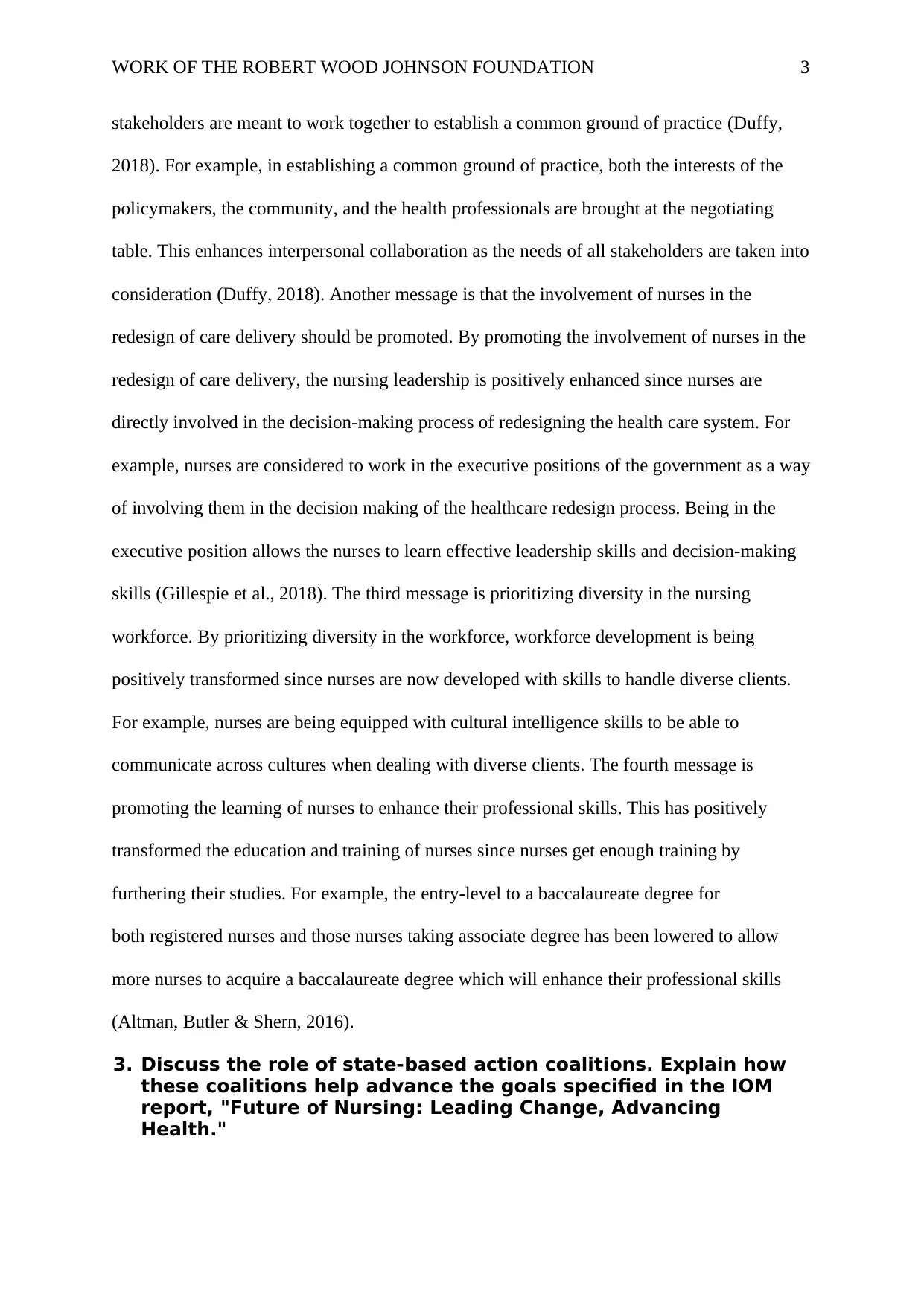
WORK OF THE ROBERT WOOD JOHNSON FOUNDATION 3
stakeholders are meant to work together to establish a common ground of practice (Duffy,
2018). For example, in establishing a common ground of practice, both the interests of the
policymakers, the community, and the health professionals are brought at the negotiating
table. This enhances interpersonal collaboration as the needs of all stakeholders are taken into
consideration (Duffy, 2018). Another message is that the involvement of nurses in the
redesign of care delivery should be promoted. By promoting the involvement of nurses in the
redesign of care delivery, the nursing leadership is positively enhanced since nurses are
directly involved in the decision-making process of redesigning the health care system. For
example, nurses are considered to work in the executive positions of the government as a way
of involving them in the decision making of the healthcare redesign process. Being in the
executive position allows the nurses to learn effective leadership skills and decision-making
skills (Gillespie et al., 2018). The third message is prioritizing diversity in the nursing
workforce. By prioritizing diversity in the workforce, workforce development is being
positively transformed since nurses are now developed with skills to handle diverse clients.
For example, nurses are being equipped with cultural intelligence skills to be able to
communicate across cultures when dealing with diverse clients. The fourth message is
promoting the learning of nurses to enhance their professional skills. This has positively
transformed the education and training of nurses since nurses get enough training by
furthering their studies. For example, the entry-level to a baccalaureate degree for
both registered nurses and those nurses taking associate degree has been lowered to allow
more nurses to acquire a baccalaureate degree which will enhance their professional skills
(Altman, Butler & Shern, 2016).
3. Discuss the role of state-based action coalitions. Explain how
these coalitions help advance the goals specified in the IOM
report, "Future of Nursing: Leading Change, Advancing
Health."
stakeholders are meant to work together to establish a common ground of practice (Duffy,
2018). For example, in establishing a common ground of practice, both the interests of the
policymakers, the community, and the health professionals are brought at the negotiating
table. This enhances interpersonal collaboration as the needs of all stakeholders are taken into
consideration (Duffy, 2018). Another message is that the involvement of nurses in the
redesign of care delivery should be promoted. By promoting the involvement of nurses in the
redesign of care delivery, the nursing leadership is positively enhanced since nurses are
directly involved in the decision-making process of redesigning the health care system. For
example, nurses are considered to work in the executive positions of the government as a way
of involving them in the decision making of the healthcare redesign process. Being in the
executive position allows the nurses to learn effective leadership skills and decision-making
skills (Gillespie et al., 2018). The third message is prioritizing diversity in the nursing
workforce. By prioritizing diversity in the workforce, workforce development is being
positively transformed since nurses are now developed with skills to handle diverse clients.
For example, nurses are being equipped with cultural intelligence skills to be able to
communicate across cultures when dealing with diverse clients. The fourth message is
promoting the learning of nurses to enhance their professional skills. This has positively
transformed the education and training of nurses since nurses get enough training by
furthering their studies. For example, the entry-level to a baccalaureate degree for
both registered nurses and those nurses taking associate degree has been lowered to allow
more nurses to acquire a baccalaureate degree which will enhance their professional skills
(Altman, Butler & Shern, 2016).
3. Discuss the role of state-based action coalitions. Explain how
these coalitions help advance the goals specified in the IOM
report, "Future of Nursing: Leading Change, Advancing
Health."
⊘ This is a preview!⊘
Do you want full access?
Subscribe today to unlock all pages.

Trusted by 1+ million students worldwide
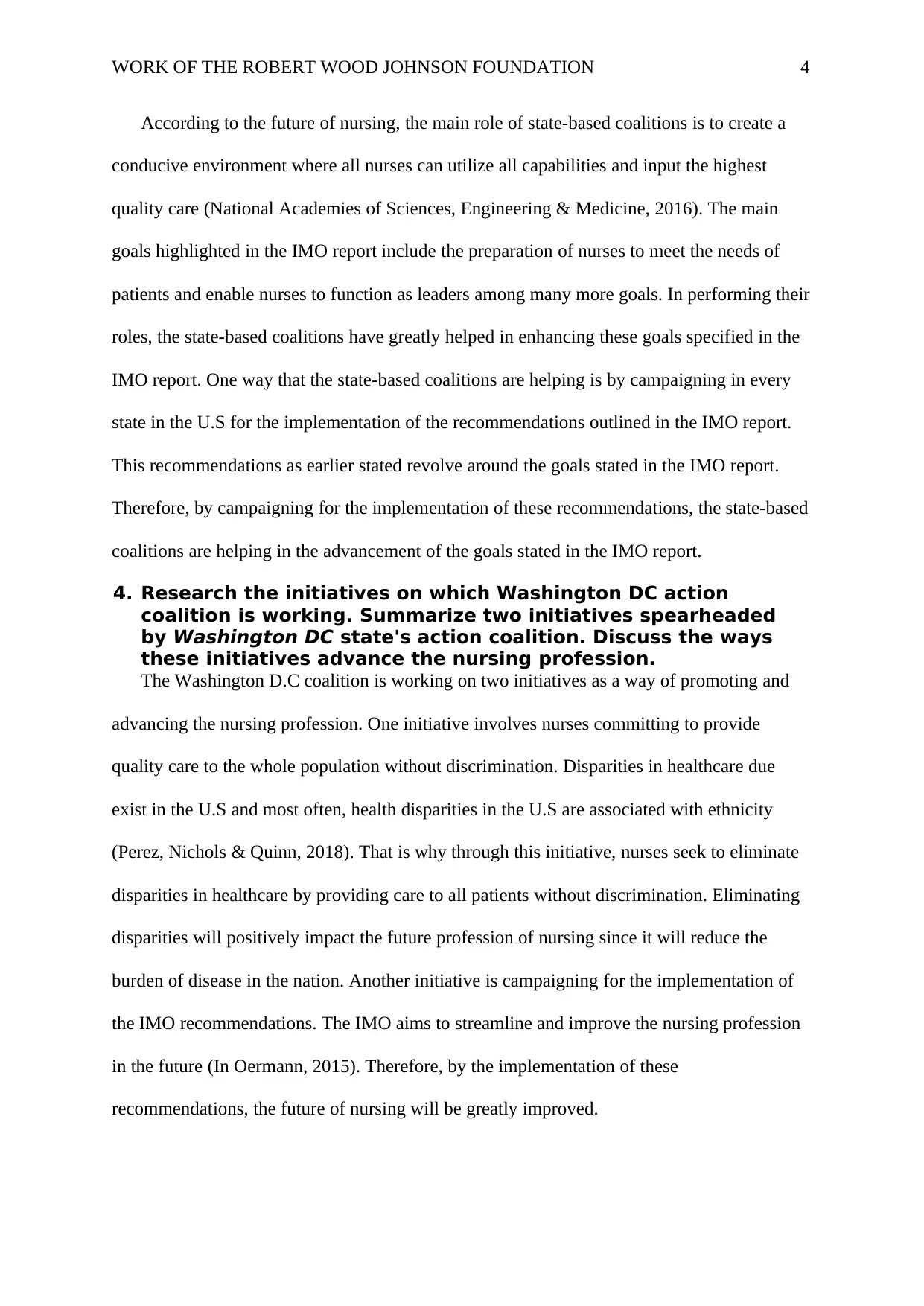
WORK OF THE ROBERT WOOD JOHNSON FOUNDATION 4
According to the future of nursing, the main role of state-based coalitions is to create a
conducive environment where all nurses can utilize all capabilities and input the highest
quality care (National Academies of Sciences, Engineering & Medicine, 2016). The main
goals highlighted in the IMO report include the preparation of nurses to meet the needs of
patients and enable nurses to function as leaders among many more goals. In performing their
roles, the state-based coalitions have greatly helped in enhancing these goals specified in the
IMO report. One way that the state-based coalitions are helping is by campaigning in every
state in the U.S for the implementation of the recommendations outlined in the IMO report.
This recommendations as earlier stated revolve around the goals stated in the IMO report.
Therefore, by campaigning for the implementation of these recommendations, the state-based
coalitions are helping in the advancement of the goals stated in the IMO report.
4. Research the initiatives on which Washington DC action
coalition is working. Summarize two initiatives spearheaded
by Washington DC state's action coalition. Discuss the ways
these initiatives advance the nursing profession.
The Washington D.C coalition is working on two initiatives as a way of promoting and
advancing the nursing profession. One initiative involves nurses committing to provide
quality care to the whole population without discrimination. Disparities in healthcare due
exist in the U.S and most often, health disparities in the U.S are associated with ethnicity
(Perez, Nichols & Quinn, 2018). That is why through this initiative, nurses seek to eliminate
disparities in healthcare by providing care to all patients without discrimination. Eliminating
disparities will positively impact the future profession of nursing since it will reduce the
burden of disease in the nation. Another initiative is campaigning for the implementation of
the IMO recommendations. The IMO aims to streamline and improve the nursing profession
in the future (In Oermann, 2015). Therefore, by the implementation of these
recommendations, the future of nursing will be greatly improved.
According to the future of nursing, the main role of state-based coalitions is to create a
conducive environment where all nurses can utilize all capabilities and input the highest
quality care (National Academies of Sciences, Engineering & Medicine, 2016). The main
goals highlighted in the IMO report include the preparation of nurses to meet the needs of
patients and enable nurses to function as leaders among many more goals. In performing their
roles, the state-based coalitions have greatly helped in enhancing these goals specified in the
IMO report. One way that the state-based coalitions are helping is by campaigning in every
state in the U.S for the implementation of the recommendations outlined in the IMO report.
This recommendations as earlier stated revolve around the goals stated in the IMO report.
Therefore, by campaigning for the implementation of these recommendations, the state-based
coalitions are helping in the advancement of the goals stated in the IMO report.
4. Research the initiatives on which Washington DC action
coalition is working. Summarize two initiatives spearheaded
by Washington DC state's action coalition. Discuss the ways
these initiatives advance the nursing profession.
The Washington D.C coalition is working on two initiatives as a way of promoting and
advancing the nursing profession. One initiative involves nurses committing to provide
quality care to the whole population without discrimination. Disparities in healthcare due
exist in the U.S and most often, health disparities in the U.S are associated with ethnicity
(Perez, Nichols & Quinn, 2018). That is why through this initiative, nurses seek to eliminate
disparities in healthcare by providing care to all patients without discrimination. Eliminating
disparities will positively impact the future profession of nursing since it will reduce the
burden of disease in the nation. Another initiative is campaigning for the implementation of
the IMO recommendations. The IMO aims to streamline and improve the nursing profession
in the future (In Oermann, 2015). Therefore, by the implementation of these
recommendations, the future of nursing will be greatly improved.
Paraphrase This Document
Need a fresh take? Get an instant paraphrase of this document with our AI Paraphraser
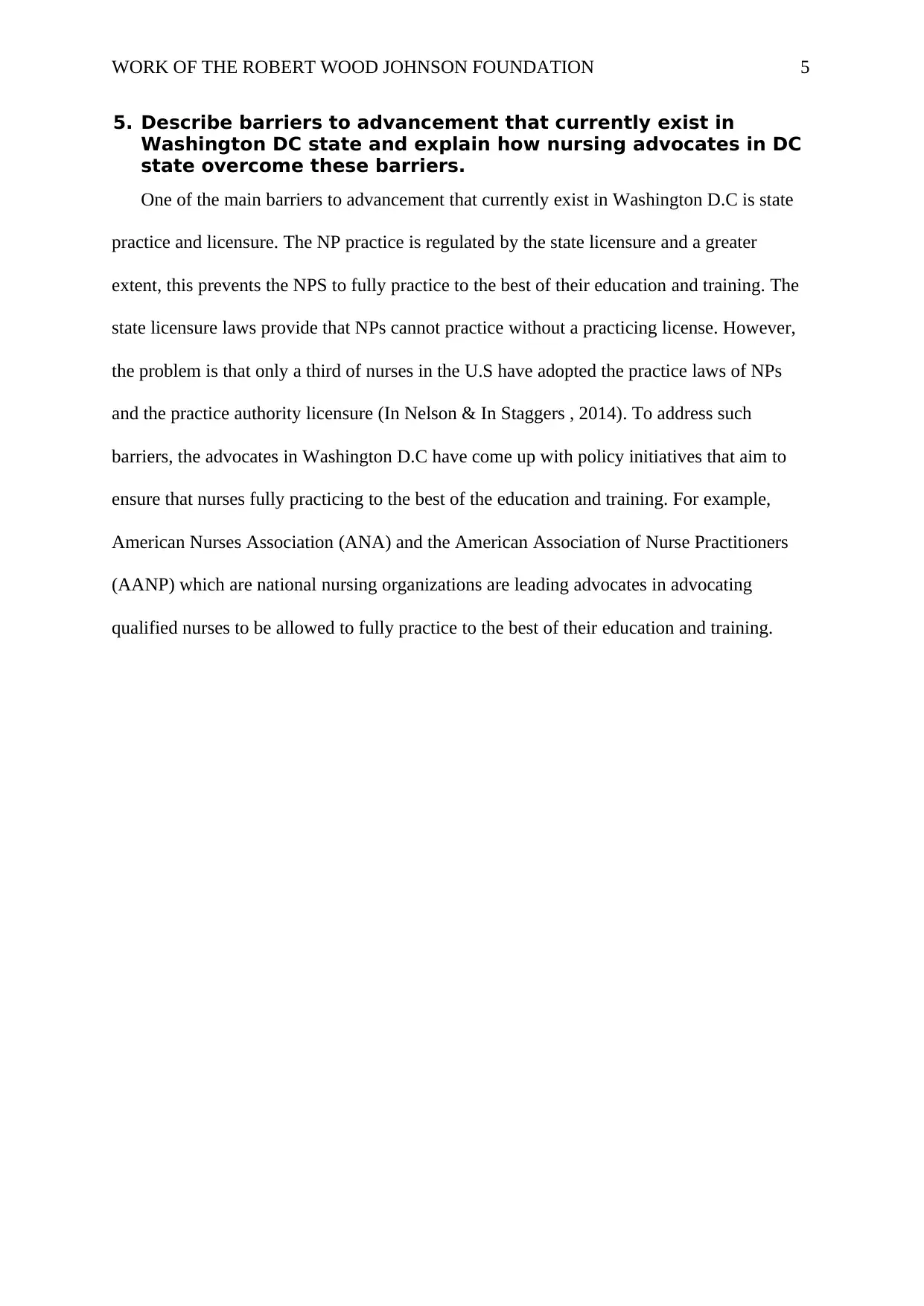
WORK OF THE ROBERT WOOD JOHNSON FOUNDATION 5
5. Describe barriers to advancement that currently exist in
Washington DC state and explain how nursing advocates in DC
state overcome these barriers.
One of the main barriers to advancement that currently exist in Washington D.C is state
practice and licensure. The NP practice is regulated by the state licensure and a greater
extent, this prevents the NPS to fully practice to the best of their education and training. The
state licensure laws provide that NPs cannot practice without a practicing license. However,
the problem is that only a third of nurses in the U.S have adopted the practice laws of NPs
and the practice authority licensure (In Nelson & In Staggers , 2014). To address such
barriers, the advocates in Washington D.C have come up with policy initiatives that aim to
ensure that nurses fully practicing to the best of the education and training. For example,
American Nurses Association (ANA) and the American Association of Nurse Practitioners
(AANP) which are national nursing organizations are leading advocates in advocating
qualified nurses to be allowed to fully practice to the best of their education and training.
5. Describe barriers to advancement that currently exist in
Washington DC state and explain how nursing advocates in DC
state overcome these barriers.
One of the main barriers to advancement that currently exist in Washington D.C is state
practice and licensure. The NP practice is regulated by the state licensure and a greater
extent, this prevents the NPS to fully practice to the best of their education and training. The
state licensure laws provide that NPs cannot practice without a practicing license. However,
the problem is that only a third of nurses in the U.S have adopted the practice laws of NPs
and the practice authority licensure (In Nelson & In Staggers , 2014). To address such
barriers, the advocates in Washington D.C have come up with policy initiatives that aim to
ensure that nurses fully practicing to the best of the education and training. For example,
American Nurses Association (ANA) and the American Association of Nurse Practitioners
(AANP) which are national nursing organizations are leading advocates in advocating
qualified nurses to be allowed to fully practice to the best of their education and training.
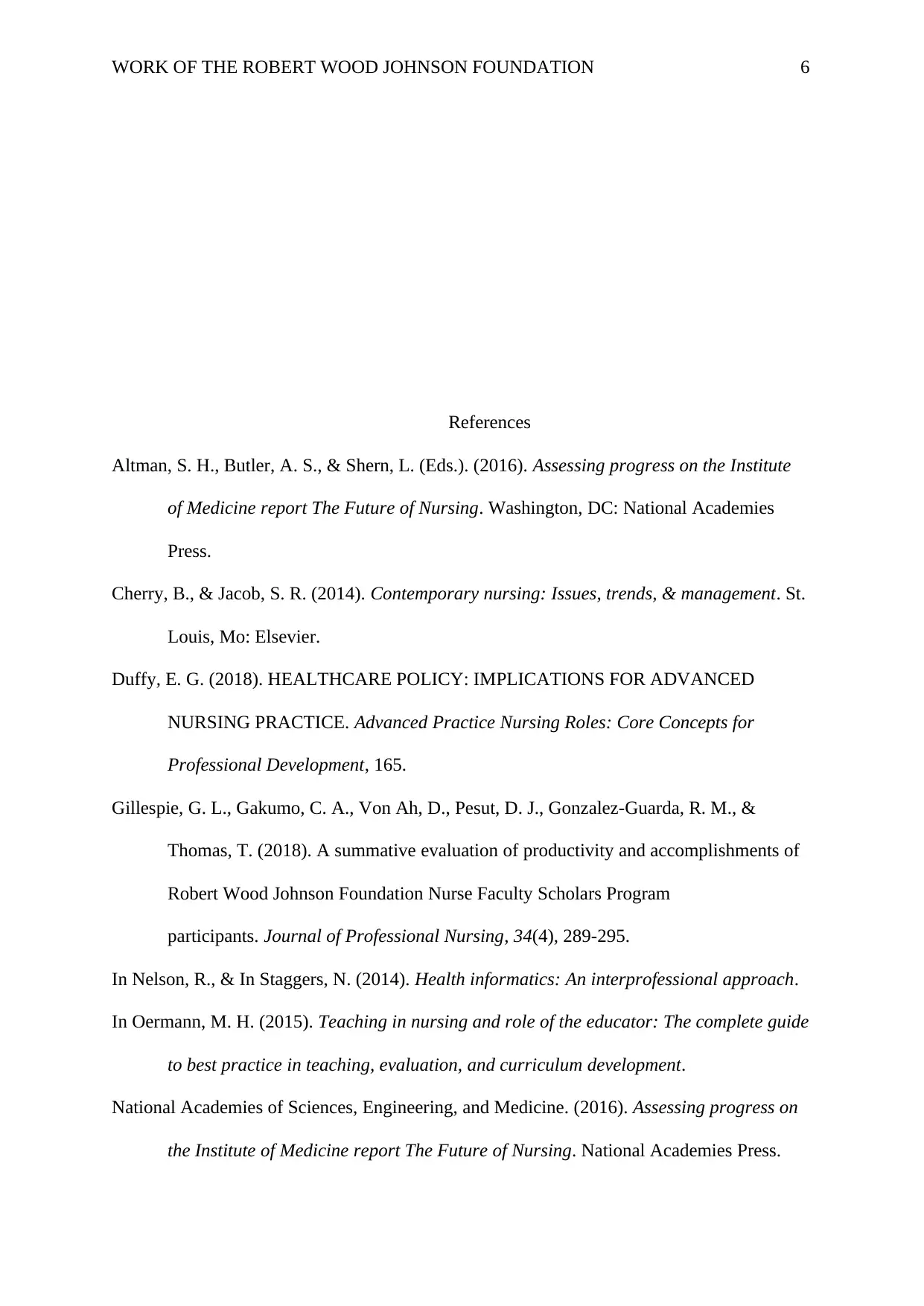
WORK OF THE ROBERT WOOD JOHNSON FOUNDATION 6
References
Altman, S. H., Butler, A. S., & Shern, L. (Eds.). (2016). Assessing progress on the Institute
of Medicine report The Future of Nursing. Washington, DC: National Academies
Press.
Cherry, B., & Jacob, S. R. (2014). Contemporary nursing: Issues, trends, & management. St.
Louis, Mo: Elsevier.
Duffy, E. G. (2018). HEALTHCARE POLICY: IMPLICATIONS FOR ADVANCED
NURSING PRACTICE. Advanced Practice Nursing Roles: Core Concepts for
Professional Development, 165.
Gillespie, G. L., Gakumo, C. A., Von Ah, D., Pesut, D. J., Gonzalez-Guarda, R. M., &
Thomas, T. (2018). A summative evaluation of productivity and accomplishments of
Robert Wood Johnson Foundation Nurse Faculty Scholars Program
participants. Journal of Professional Nursing, 34(4), 289-295.
In Nelson, R., & In Staggers, N. (2014). Health informatics: An interprofessional approach.
In Oermann, M. H. (2015). Teaching in nursing and role of the educator: The complete guide
to best practice in teaching, evaluation, and curriculum development.
National Academies of Sciences, Engineering, and Medicine. (2016). Assessing progress on
the Institute of Medicine report The Future of Nursing. National Academies Press.
References
Altman, S. H., Butler, A. S., & Shern, L. (Eds.). (2016). Assessing progress on the Institute
of Medicine report The Future of Nursing. Washington, DC: National Academies
Press.
Cherry, B., & Jacob, S. R. (2014). Contemporary nursing: Issues, trends, & management. St.
Louis, Mo: Elsevier.
Duffy, E. G. (2018). HEALTHCARE POLICY: IMPLICATIONS FOR ADVANCED
NURSING PRACTICE. Advanced Practice Nursing Roles: Core Concepts for
Professional Development, 165.
Gillespie, G. L., Gakumo, C. A., Von Ah, D., Pesut, D. J., Gonzalez-Guarda, R. M., &
Thomas, T. (2018). A summative evaluation of productivity and accomplishments of
Robert Wood Johnson Foundation Nurse Faculty Scholars Program
participants. Journal of Professional Nursing, 34(4), 289-295.
In Nelson, R., & In Staggers, N. (2014). Health informatics: An interprofessional approach.
In Oermann, M. H. (2015). Teaching in nursing and role of the educator: The complete guide
to best practice in teaching, evaluation, and curriculum development.
National Academies of Sciences, Engineering, and Medicine. (2016). Assessing progress on
the Institute of Medicine report The Future of Nursing. National Academies Press.
⊘ This is a preview!⊘
Do you want full access?
Subscribe today to unlock all pages.

Trusted by 1+ million students worldwide
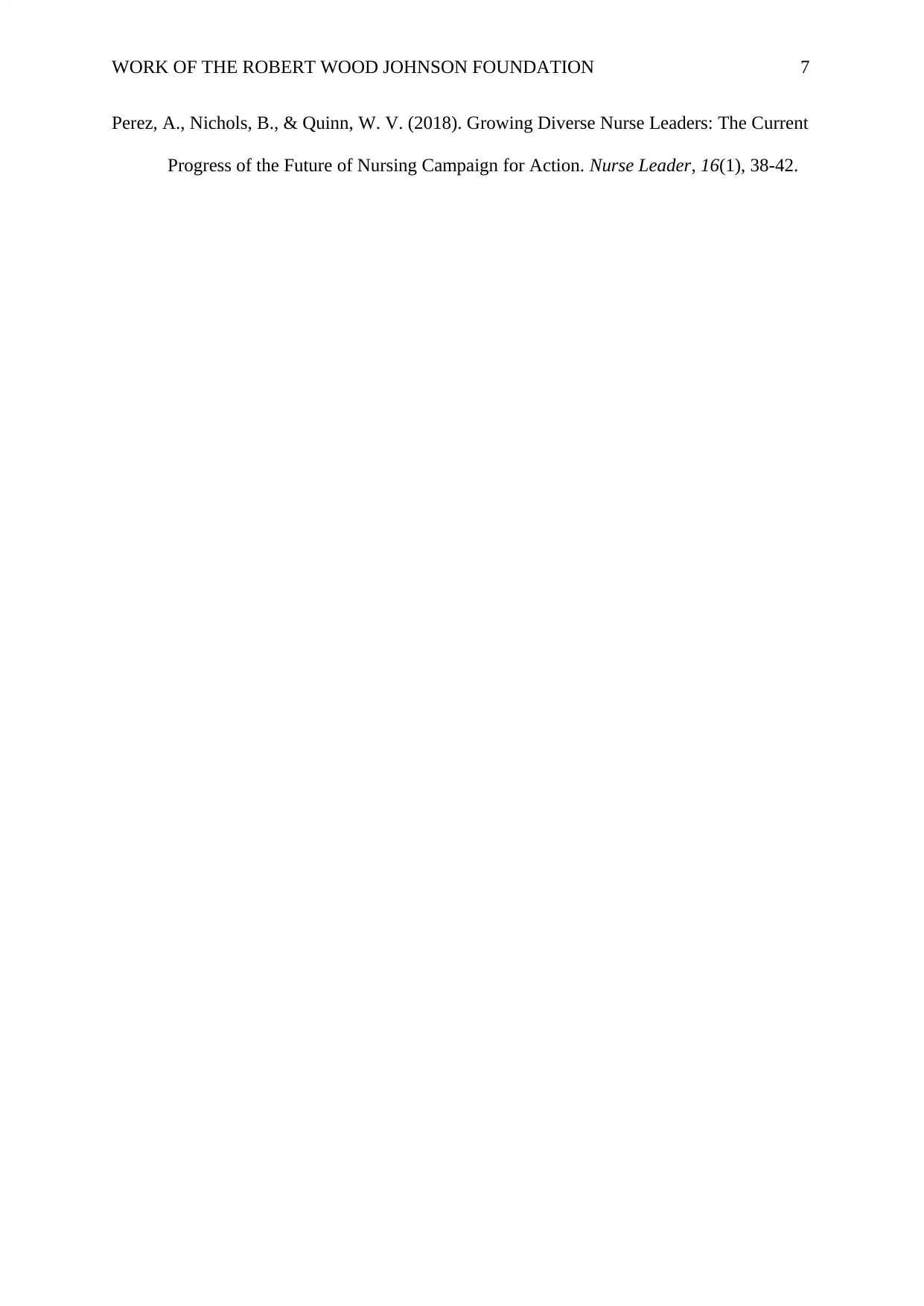
WORK OF THE ROBERT WOOD JOHNSON FOUNDATION 7
Perez, A., Nichols, B., & Quinn, W. V. (2018). Growing Diverse Nurse Leaders: The Current
Progress of the Future of Nursing Campaign for Action. Nurse Leader, 16(1), 38-42.
Perez, A., Nichols, B., & Quinn, W. V. (2018). Growing Diverse Nurse Leaders: The Current
Progress of the Future of Nursing Campaign for Action. Nurse Leader, 16(1), 38-42.
1 out of 7
Related Documents
Your All-in-One AI-Powered Toolkit for Academic Success.
+13062052269
info@desklib.com
Available 24*7 on WhatsApp / Email
![[object Object]](/_next/static/media/star-bottom.7253800d.svg)
Unlock your academic potential
Copyright © 2020–2025 A2Z Services. All Rights Reserved. Developed and managed by ZUCOL.





